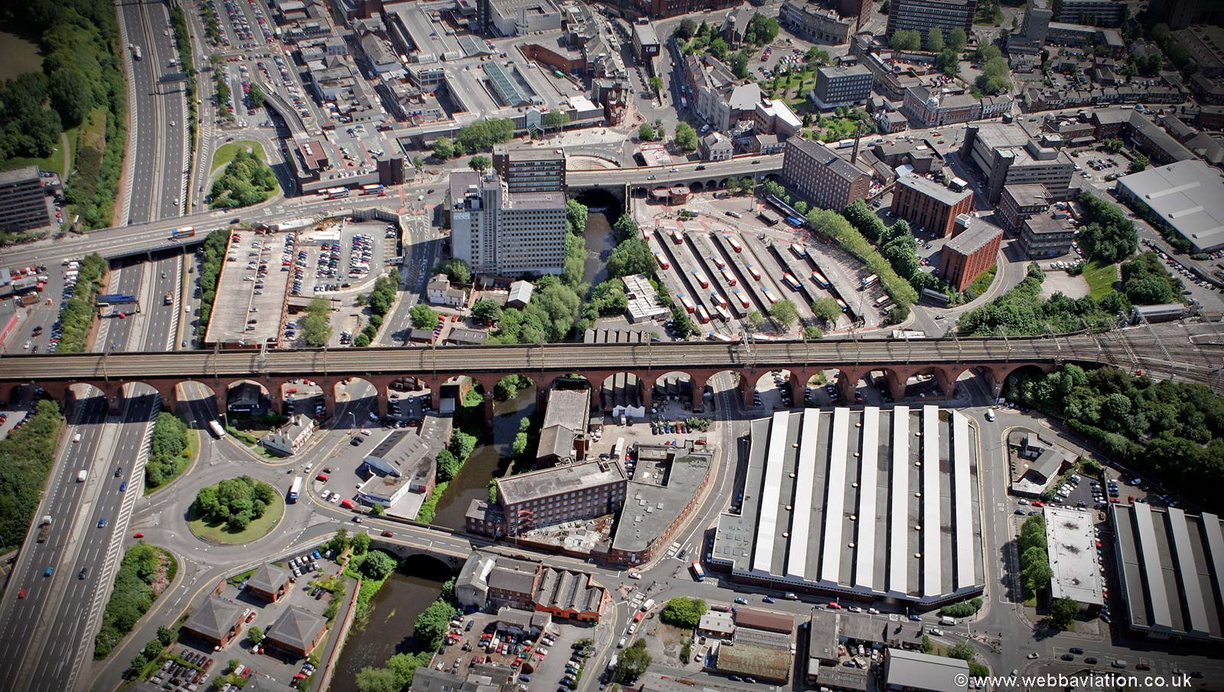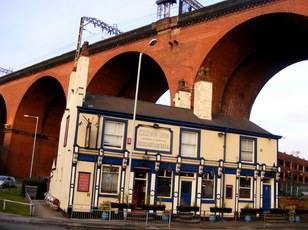For, as you should know by now, Your Humble Scribe is a rather horrid curmudgeon at heart, who is never happier than when contemplating the orphanage being foreclosed upon, or seeing someone one piece short of their 1,500 piece jigsaw.
 |
| O no, how could that happen? Where could it be? O hang on, it was here in my pocket all the time. I'll just complete it. |
Okay, those reading who aren't goldfish will recall Conrad wittering on about the Ouse Valley Viaduct and why an enormous bridge was constructed, etcetera, yaddah, blah. Well, take a look at another awesome piece of brick-built architecture. Art?
 |
| From the air |
| With puny human cars for scale |
 |
| See below |
The effect of gradients is felt even today. Doing some digging-around for this article, I found that the stretch of line from Stockport to Buxton has a gradient of one in sixty, which is sufficiently steep that there are several models of train that simply cannot manage it. And we are one hundred and eighty years more advanced than when the Viaduct was built!
Thus today's title; to be considerate of steam locomotives, the architects and planners and builders had to have as gentle a gradient - or incline- as possible. How jolly considerate of them!
 |
| Viaduct with puny human pub for scale* |
| There we go! |
Potato Pancakes, Polish Style
Or, if you like, "Placki Ziemniaczane". Conrad made seven of these this evening, for the first time ever, and they weren't bad. Art?
I cheated a little, as you can see, and used fresh parsely in the batter mix. Rather than spend an hour and some of my precious skin and blood grating by hand, I used the food processor. Perhaps I should have used the really fine grating attachment, although I suspect if Your Modest Artisan had done so there would have been a lot more water present in the batter.
There are 5 left for lunch or tea tomorrow; it would have been a bit greedy to scoff the whole lot tonight**.
Great Squeaking Bats!
I made that one up all by myself, good, isn't it? Quite serendipitous, too, because it's serendipitously relevant to our next goggle at a strip from the "Thunder" comic. Art?
 |
| A frankly rubbish cover picture. Bad editor! Naughty editor! |
 |
| Art by Mr. Font |
http://lewstringer.blogspot.com/2017/07/will-black-max-return.html
"Black Max" was popular enough to survive "Thunder"'s merging with "Lion" in 1972, and Your Humble Scribe is pretty sure he remembers reading a Summer Special wherein the RFC is trialling a gyrocopter -
- but I digress. Next!
Belt Up
This is a consequence of reading Adam Tooze's "The Wages of Destruction", where the Nazi economy pretty much lurches from one crisis to the next, even when they have occupied most of Europe. Slave labour is inefficient and Frenchmen won't work hard for an occupation force, shock horror who knew the surprise!
Also, steel, the bedrock of a modern military machine, is always a weak point for the Teutons. They don't have a native supply of iron ore, so they rely - O so desperately do they rely! - upon the flow of same from Scandinavia.
 |
| <Insert Swedish Joke here> |
| Behold the belt of bullets |
| Stuffy old British linen belt |
Finally -
This will all make sense on Facebook, honestly. First of all, we have a halibut, which name comes from the Middle Dutch "Hali" for "Holy", as it was eaten on holy days, and "Butte" for "Flat", because it is. Art?
| Thus |
- and
| - some icewater melt |
* Taunting me with WHAT I CANNOT HAVE!
** Though I could have done. I'm not soft or anything.

No comments:
Post a Comment